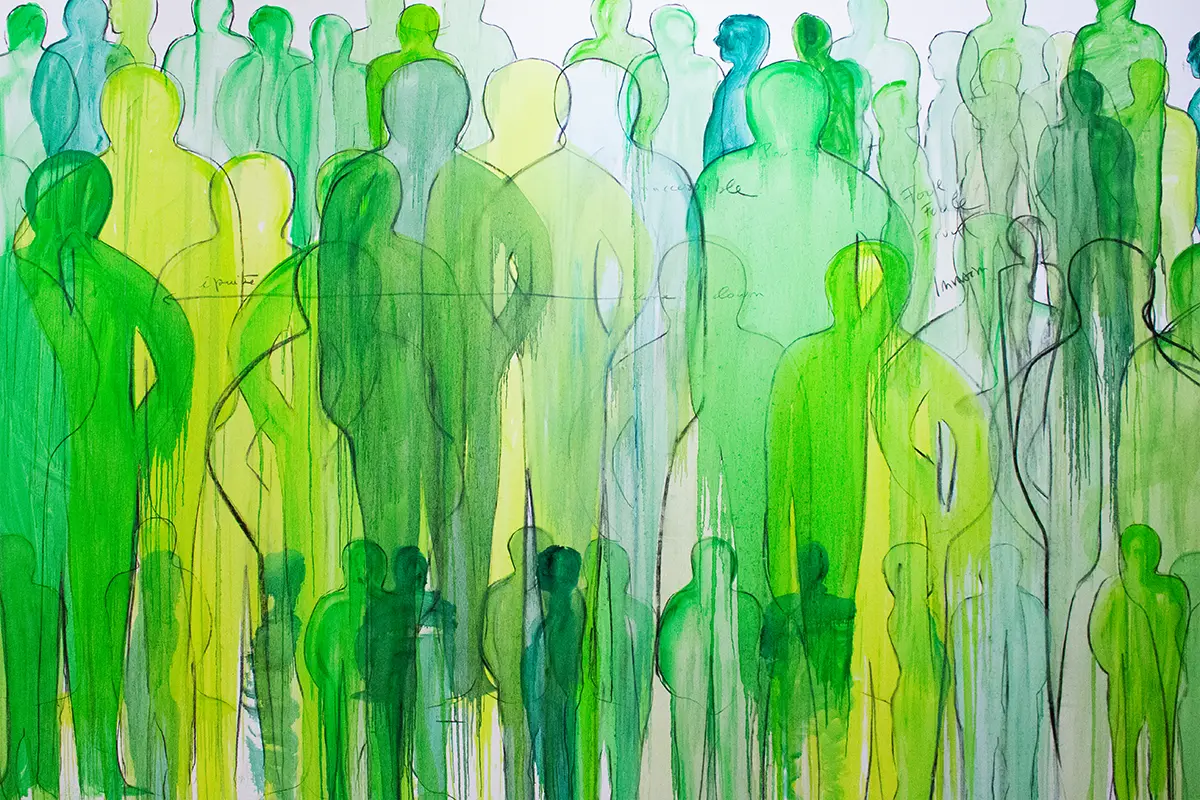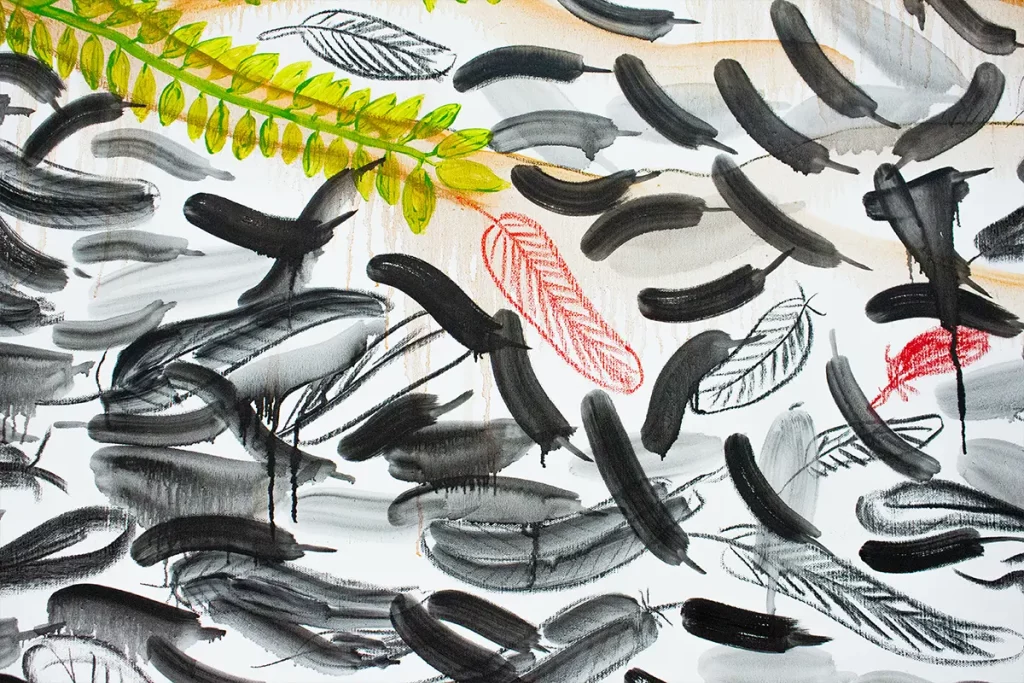We all have one goal for forests: to render them alive once again. Yanomami artist Sheroanawe Hikihiiwe and French-based artist Fabrice Hyber have created four hands for Siamo Foresta
Siamo Foresta – the exhibition at Triennale Milano
In the heart of the Vendée region, in France, artist Fabrice Hyber has been sowing a forest around the old farm of his parents, sheep farmers, since 1990. In the Vallée de la Serrie, a forest was thus born from around 300,000 seeds of hundreds of different species. A place of learning and experimentation, the Vallée has become a source of inspiration for the artist’s work, who met Yanomami artist Sheroanawe Hakihiiwe for the first time during the Les Vivants exhibition, organized by Fondation Cartier at the Tripostal in Lille during 2022.
The forest has proved to be a common denominator between Fabrice Hyber and Sheroanawe Hikihiiwe, coming from such distant places, an opportunity to reflect on the fertility of life and its metamorphoses. This time, in April 2023, Hyper’s hand-planted forest in Vandée became for the two artists the place of residence and the scene of multi-handed creation. The result of this artistic bond will flow into Siamo Foresta, the new exhibition by Fondation Cartier in partnership with Triennale Milano. Bringing together the works of twenty-one artists from different countries, cultures and contexts, mostly Latin American and from indigenous communities, Siamo Foresta – curated by Bruce Albert, anthropologist, and Hervé Chandès, Artistic Director of Fondation Cartier pour l’art contemporain – invites us to discover new points of view of contemporaneity.
The Fondation Cartier travels the world, in collaboration with major art institutions, to encourage new audiences in Western museums to engage with the visions of artists from the most diverse geographical backgrounds. More than seventy per cent of the artworks that can be seen in Siamo Foresta come from the collection of the Fondation Cartier pour l’art contemporain and tell the story of the Foundation’s long-standing relationship with artists from different indigenous communities in Central and South America to reflect on the diversity and vibrancy of their contemporary forms of expression. The encounter with these indigenous aesthetic and metaphysical worlds has thus given rise to many new works and sometimes unexpected collaborations, such as the one between Fabrice Hyber and Sheroanawe Hikihiiwe.
Sheroanawe Hikihiiwe and Fabrice Hyber – a conversation on the meaning of the forest
Fabrice Hyber. «I was born in Vandée in the West of France. When I was a child, there was a lot of industrial agriculture that came around. One day, it was possible for me to buy all the landscape to protect my family from all the agriculture. In the beginning, I didn’t want to buy anything because I wanted to be free. But the only possibility for me to protect the place where I was born was to buy it.
«In Vandée, around two hundred years ago, there were people who lived here and there were forests. When the revolution arrived, half of the people got killed and the forests got destroyed. When I decided to buy the landscape, I decided something: the best way to learn something is not to go in the field but to go in the forest.
«So, I wanted to have a forest. But not a monoculture forest. One full of species of trees, plants and everything else. I began to plant trees because everyone told me the only possibility was to plant. I then seeded them. At that time, I understood that adding the seed is difficult. In France, there are two companies that sell them and the rules are strict. When I think of that, I realize that there are a lot of things playing against life.
Sheroanawe Hikihiiwe is an artist from the Yanomami community, while Fabrice Hyber is a French-based artist
«For me it’s the right moment to speak about it and to create the link. I think that there are the same things in the Amazon forest and the forests that we have here, just not at the same moment. It’s not the same forest of course but we have the same idea to fill the forests with life. For me the most effective thing is to think that all you can see around you is a part of your body and it’s all for you. There are many other things but this is the basis for why I thought to have a forest.»
Sheroanawe Hikihiiwe. «Where we were in the Vandée is a quiet place, peaceful and ideal for putting creativity to work. The forest that Fabrice is making is a refuge for the animals there and the water is also conserved. In the works that we did together, the jungle and the forest came together as a family, all healthy and in harmony.»
Fondation Cartier wants to challenge artists to rethink how we interact with our surroundings and society
This exhibition encourages artists from completely different views to collaborate and come together. Whilst the similarities clearly work in favor of the creative flow, the artists need to embrace their differences to ensure that the outcome tells both sides of the story. Respect is a crucial factor as their beliefs must tie-in together to form a united front. In this case, to defend the forests.
Fabrice Hyber. «We met together one year ago when we did a show together in Lille. It was difficult to speak together because there are three languages so there is a lot of translation. We had to find the precise balance between everything. They did some drawings and they offered me the drawings. It was something strong for me. It was a good moment and we decided to invite them this year to do something together.
«This year when they arrived, we decided to do something together. I wanted to know more about Sheroanawe: what he’s like and his mind. I asked him if we could put together the Amazon forest and the Vandée forest all together to make a link. When you see the mix of the drawings it is different; you don’t see that much. It’s a new invention. There are artists who make mixed art but they’re from the same culture. We try to make the link to put them together. In this case, the link was the forest.
«It’s a real conversation but not in the same language; we had two people with us to help with that. For me, we are on the same level. I don’t like that there are different levels. I make sure that there is no power. It’s about the power of the drawings, not the potency of power.»
Sheroanawe Hikihiiwe. «I didn’t know that I was going to get out of this experience, they invited me and I was open to doing it, for me it was a surprise how well it turned out, we worked with great joy and respect for each other and also listening to each other how is the jungle of each one. It was the second time we had seen each other, but the first time we had the opportunity to talk, talk about our jobs, our stories, etc. I learned from this experience and I think Fabrice too.
«Each place has its different conditions, as well as different problems and possible solutions, but the idea of conserving the forest and the jungle is present in both of us (Fabrice and I) as artists and people who live on this earth.»
Sheroanawe Hikihiiwe and Fabrice Hyber, respecting the relationship between indigenous and non-indigenous individuals
Fabrice Hyber. «We created something together. Not that all the pieces are separate from each other. The base of his culture and the base of my culture are different but other than that, there is a link between everything. We just have to embrace the differences. We both stepped over our limits for this, which was good. When we draw together, respect is the basis: the colors, the lines need to match. The horizon for us, is flat. For them, the horizon is a spiral, leading up to the trees.»
Actively defending the forest and spreading urgent messages can be done with different mediums. Art and drawings is one of those ways. Above and beyond change, art has always been a tool to inspire others. That is what Hyber and Hikihiiwe aimed to do with their blended artworks.
Fabrice Hyber. «Information is like a seed. A seed is small but you can get something big after a while. When you tell someone a word or a sentence, you give them a seed. And then this seed, perhaps, may grow. Sometimes we don’t have to speak about it and sometimes we do. You can keep the garden quiet sometimes and other times you have to take care of it. My saying is that one minus minus equals to two; we spoke about the negative becoming a positive. When you kill something, you kill a part of you. Always.
«It’s like in the 19th century: we never used to go to the seaside. And then one artist drew people at the beach and since then, we always go. Artists have no limits. They want to make something new and with that, you can look at the artist from the Amazon as a real artist. We are all in the same world. More than the same world, we are in the same universe.
«You have to give people the possibility to do something. In the countryside here, there is no culture. But when they have the possibility to link with an artist like me or another artist, they can see just how many possibilities there are in the world. It always opens up a new door.»
Using art as a medium to spread a message — defending the forest
Sheroanawe Hikihiiwe. «Art can be a tool to change things that are bad, or at least to let people know that there are things that are going wrong in the jungle, but there is always hope to fix things. It all depends on people being informed and wanting to change.
«There are always other ways to talk and think about these issues; You can talk, you can make visits, videos and people from many different places meet so that everyone can talk and listen to what each other has to say.»
The aim of the exhibition — Siamo Foresta
Fabrice Hyber. «We have to take care of our way of life. We have to rebuild and feed our biotope. I feel like the show should be one big biotope.»
Sheroanawe Hikihiiwe. «All animals, plants, trees, water, rivers; everything is related. They cannot be separated from each other, they are all the same, we call all that Urihi, which is the jungle, but it is also the place where we live. You can’t live without Urihi.»




















